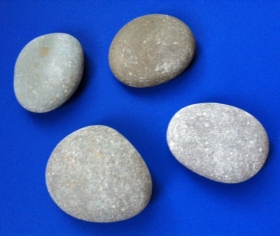
If you’re near the Los Angeles area, you’ll have a rare chance to see some of the world’s most fascinating Pacific Island drums on display as part of an exhibit on the art and culture of Papua, New Guinea. Currently at the Bowers Museum in Santa Ana, California (USA) is an exhibit entitled: Spirits and Headhunters, Art of the Pacific Islands that shares impressive cultural artifacts including many that reflect the music and dance of this region.
So what’s so different about drums from New Guinea?
The first thing you might notice is the  impressive size of the slit drums featured in this exhibit. In fact, the two large slit drums on display (pictured right and below, left) are each the size and shape of a large canoe! Hollowed out partially inside, both slit drums are struck with beaters, put on a type of cart and moved from place to place while being played. The smaller drum (below) was created and decorated with the motif of
impressive size of the slit drums featured in this exhibit. In fact, the two large slit drums on display (pictured right and below, left) are each the size and shape of a large canoe! Hollowed out partially inside, both slit drums are struck with beaters, put on a type of cart and moved from place to place while being played. The smaller drum (below) was created and decorated with the motif of  a crocodile, who is considered to be an ancestor spirit in the Sepik region. In this area, the drum is played near a river and it is sometimes considered that drum itself is a spirit and that it’s tones reflect the voice of the ancestors or the divine.
a crocodile, who is considered to be an ancestor spirit in the Sepik region. In this area, the drum is played near a river and it is sometimes considered that drum itself is a spirit and that it’s tones reflect the voice of the ancestors or the divine.
In addition to the “horizontal” slit drums, there are also several large standing wood sculptures that resemble 10 – 15 foot totem poles (pictured above left). Remarkably, these are also slit drums and are played with beaters as well, often used as methods of communication between tribes or groups of people.
 Of course, there are also the more traditional looking drums like those seen here as well as an example of a finger-drum which which would have had a lizard skin “head” from the Massim culture of the Milne Bay province of Papua, New Guinea. All in all, this relatively small exhibit is an amazingly deep journey into the musical, spiritual and artistic life of this important world culture.
Of course, there are also the more traditional looking drums like those seen here as well as an example of a finger-drum which which would have had a lizard skin “head” from the Massim culture of the Milne Bay province of Papua, New Guinea. All in all, this relatively small exhibit is an amazingly deep journey into the musical, spiritual and artistic life of this important world culture.
For complete information on this exhibit, check out the museum website here: http://www.bowers.org/index.php/exhibitions/current-exhibitions/150-spirits-and-headhunters-art-of-the-pacific-islands
 Although we don’t generally cover news about crowd-sourced projects, this one is so different and so special, we wanted to share it here and encourage you to participate.
Although we don’t generally cover news about crowd-sourced projects, this one is so different and so special, we wanted to share it here and encourage you to participate.






